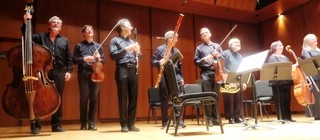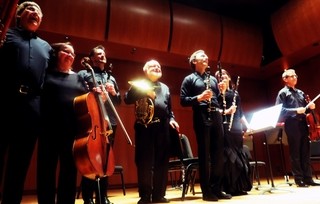|
Back
Bringing the Two B’s Down to Size New York
Gilder Lehrmann Hall, Morgan Library
06/19/2018 - & June 20*, 24, 2018
Brahms and the Search for a Symphony:
Ludwig van Beethoven: Symphony No. 2 in D Major, Op. 36 (arr. Andy Stein)
Johannes Brahms: Serenade No. 1 in D major, Op. 11 (reconstruction Alan Boustead)
St Luke’s Chamber Ensemble: Elizabeth Mann (Flute), Jon Manasse, Dean LeBlanc (Clarinets), Marc Goldberg (Bassoon), Joseph Anderer (French Horn), Krista Bennion Feeney, Jesse Mills (Violins), David Cerutti (Viola), Daire FitzGerald (Cello), John Feeney (Bass)
Alan J. Benson (Pre-concert discussion)

St. Luke Chamber Ensemble (Beethoven) (© Samuel A.Dog)
One has the unsettling feeling that the Morgan Library might have conceived a “Brahms Festival”, to which a few elderly folk might attend, and others might yawn.
Nothing against that composer, of course. But in the Age of Salonen and Thorvaldsdóttir, the great gray composer might have seemed...well, great, gray and relatively antediluvian.
The Morgan Library instead scheduled three weeks of chamber pieces by Brahms and other composers–as well as fascinating pre-concert lectures, gilding the composer and adding fascinating details.
I was unable to attend the first two weeks, but was intrigued to attend this final concert, which provided a transcription and a reconstruction. First, a transcription of the Golem who pursued Brahms for the first 43 years of his life. And then for the Brahms piece which had been written as an “excuse” to postpone expiating that Golem. Who, of course, was Ludwig van Beethoven, the composer Brahms was fearful of following.
Andrew Stein took the Beethoven symphony least eminent in the public mind, reducing it to eight players. A string quartet was appended with one double-bass, clarinet, bassoon and horn, the same ensemble as the Schubert Octet. And as Alan Benson remarked, the same kind of ensemble which 19th Century homes might have used in performing more symphonic works.
This was hardly original (think of Mahler’s transcriptions of Beethoven, Liszt, even Bruckner). Yet for those who know the original Second Symphony, something was lacking here. This wasn’t the fault of the splendid St. Luke’s Chamber Ensemble. True, the horn-player was off more than on (remedied in the following work, where he was perfect). And, possibly because I was sitting on the side of the double-bass and clarinet, it seemed darker than the original.
Even this, though, couldn’t make the original Symphony into a chamber work. These larger chamber pieces of Beethoven and Schubert kept every instrument plugging away, each movement was a contrapuntal challenge. Too often here, Mr. Stein permitted his winds to repeat notes over and over again, like the tuttis of a larger orchestra.
Nor could the combination of bassoon and horn replicate Beethoven’s martial trumpets, or the bassoon solo imitate the frequent flute/bassoon duets. The Larghetto was more successful, those dark instruments well into Beethoven’s own. The finale was jaunty enough, but without the timpani pounding, all these rhythmic accentuations seemed a bit lightweight.

St. Luke’s Chamber Ensemble (Schubert) (© Samuel A. Dog)
Far more successful–for a particular reason–was the “reconstruction” of Brahms’ First Serenade. In fact, until Mr. Benson’s almost offhand comment that Brahms had written this piece originally for chamber group had I realized that Alan Boustead was attempting what Brahms himself had attempted.
Fearful of writing a “symphony” (he felt such an appellation was proprietary to Beethoven), he wrote a long octet for winds and strings. Then he rewrote it for a chamber nonet. And finally–at the request of Clara Schumann and Joseph Joachim–he turned that into the Serenade.
Why did he destroythe first two pieces? Nobody knows. But Mr. Boustead did a splendid job in allowing his four string players to be augmented, colored and re-constructed with flute, two clarinets, bassoon and French horn. Adding to that, both clarinets switched to alto clarinet, adding even lighter sounds.
To those of us not ardent Brahmsans, the Serenade is a wondrous piece, with an airy lightness which would have done credit to Haydn. Perhaps there were a few mini-quotes from Beethoven, perhaps it sounded very much like Dvorák (Brahms’ love for East European music), and anachronistically, the opening had the sounds of nature which Mahler produced in his own First Symphony.
(Even more stunning, the birdcalls, headed by a lovely flute solo by Elizabeth Mann, could have come from Dvorák’s Eighth Symphony, written decades later.)
For this work, one didn’t have to think about the original, though again one missed the last-movement timpani. It goes without saying that the soloists of the St. Luke’s Orchestra animated those reconstructed notes with all their well-deserved skills, producing a “new” Brahms, both charming and high-spirited.
Harry Rolnick
|